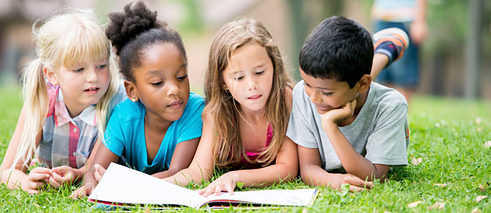Diversity in Children’s Books
Heroes from Immigrant Backgrounds Wanted

When it comes to the way modern German society is depicted, children's literature in Germany still has some catching up to do.
When Ms. Waas finally opened the strange parcel, the residents of Lummerland were amazed – a dark-skinned baby had come in the mail and was looking at the world around him with his big, wide eyes. The readers of Michael Ende's classic German children's book, Jim Button and Luke the Engine Driver, were probably equally amazed when the book was first published in 1960. It was the story of Jim, a young hero who has all kinds of amazing adventures, but this time it was really something quite new for German children's books – of course he was loveable, enterprising and smart, but, as we would say today, he came from an immigrant background.
In the meantime it has really become quite hard to imagine German kindergartens and schools without any smart and loveable children who stem from an immigrant background. When it comes to picture books and children’s literature, however, there is still a long way to go before they will be represented as naturally as they are in reality. This is a situation that primarily concerns families who do not have their roots in Germany only. Publishers occasionally receive letters from such families in which they describe their situation – their children do not see themselves or their lives reflected in the books available.
Dark-skinned people are few and far between
Maimouna, an intercultural care facility in Hamburg, had a similar experience when, back in 2012, it wanted to display children’s books with black heroines as part of an exhibition. The organisers were forced to admit that in most children’s books published in Germany there were hardly any dark-skinned people. They found them in the USA and the UK, which came as no surprise at all to Klaus Humann from the Aladin publishing house who said, "We tend to buy books about being different from abroad." The way they deal with the issue abroad, he said, is much more a matter of course and uncomplicated, whereas books published in Germany often come over as somewhat forced.Although in German children's books there are some figures from an immigrant background, they are almost always a member of a group, not an individual hero. Whether in Dancing Girls by Heike Abidi or Fussball-Haie (i.e. Soccer Sharks) by Andreas Schlüter and Irene Margil – in the meantime almost every gang of friends made on holiday, girlfriends’ clique or sports team has members whose families or parents originate from other countries. That was not always the case. "How proud we were," says Humann, who was head of the Carlsen publishing house until 2012, "when, after about 15 years, we enrolled a Turkish girl at the kindergarten where the story of Conni takes place!" Conni is a series in which the world is explained to children via the main character, a girl called Conni, and it is one of the perennial favourites at Carlsen publishing house.
And that is precisely the kind of success that so many publishers seem to be striving for. "Any children's book with a hero form a foreign background," says a bookseller in conversation, "is immediately perceived as a problem book, especially by parents. And, after all, it is the parents who buy children's books." An employee at a major German publishing house even reports that figures who are clearly described in the stories as being of African or Asian origins are deliberately depicted in an ambiguous way on the cover illustration. Sometimes, she went on to say, when the book is translated, the publishing house occasionally has the illustration reprocessed so that the colour of the figures’ skin appears lighter, therefore more geared to the German market. Once again it is the parents the publishers have in mind who might think a book showing dark skin colour could be a book about integration. Shouldn’t they actually be promoting integration?
On the other hand – dogmatic online reviews
The issue is tricky and dealing with it often involves a lot of chopping and changing. Those white European authors who write stories about dark-skinned heroes in Africa, hear, on the one hand, that they should steer clear of such subject matter. That was what children's book author Kirsten Boie was told in connection with her latest book about a bright young lad called Thabo who, in a country in southern Africa, has to become a detective and a gentleman when he deals with the case of the dead rhino, as is hinted at in the German title Thabo – Detektiv & Gentleman: Der Nashorn-Fall. On the other hand, there are reviews of children's books on Amazon, which only list the number of children in the book from an immigrant background and what role they play, always compared to the number of obviously German characters. Monika Osberghaus from Klett Kinderbuch publishing house calls these dogmatists "Blond Counters". She feels it is only a matter of time before the issue will quite unemotionally make its way onto the pages of picture and children's books.Her publishing house has brought out a series called Die wilden Zwerge (i.e. The Wild Dwarves) by Meyer, Lehmann, Schulze and it is a really good example of how this can happen: In this story about a lively group of kindergarten kids the reader cannot immediately see that some of the boys’ and girls’ families come from other countries. Sometimes it is just a single sentence that reveals that one of the boys, for example, is a child who comes from a family of ethnic Germans from Kazakhstan. It's no big deal, but it is an additional plus point for the book.